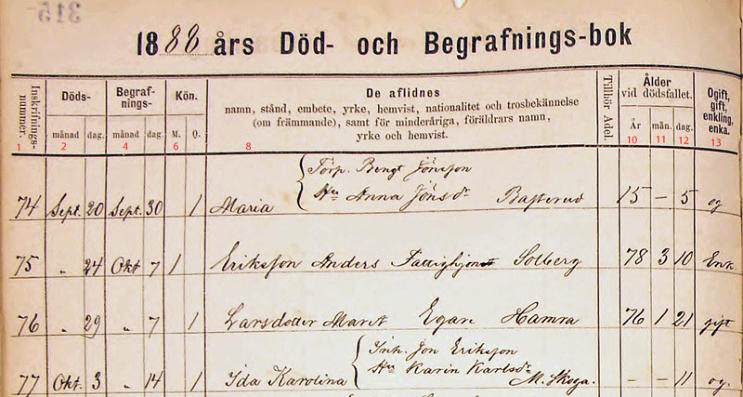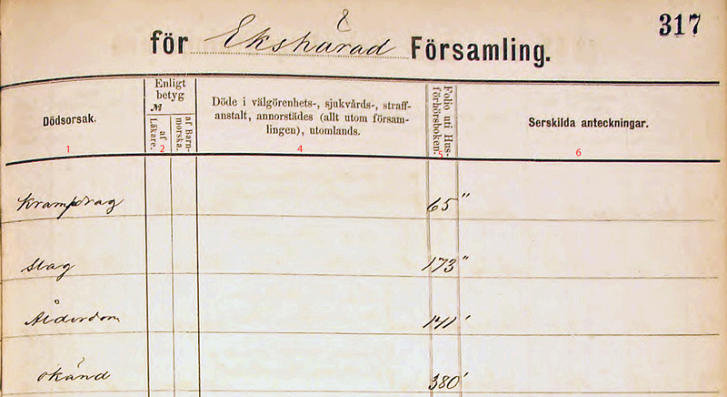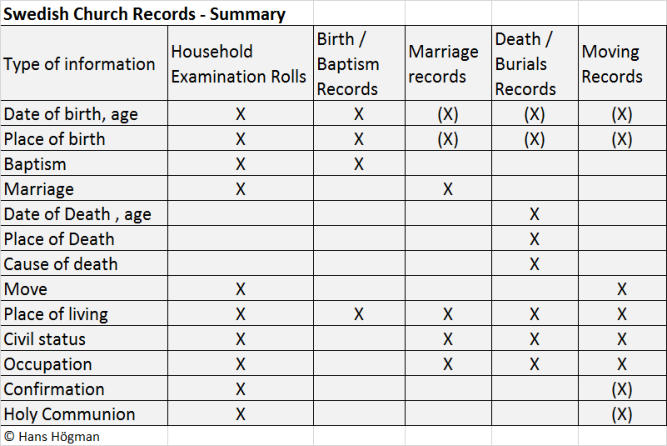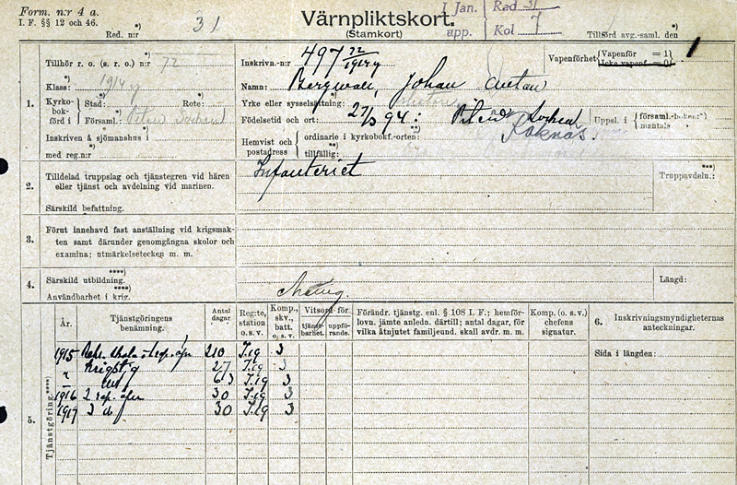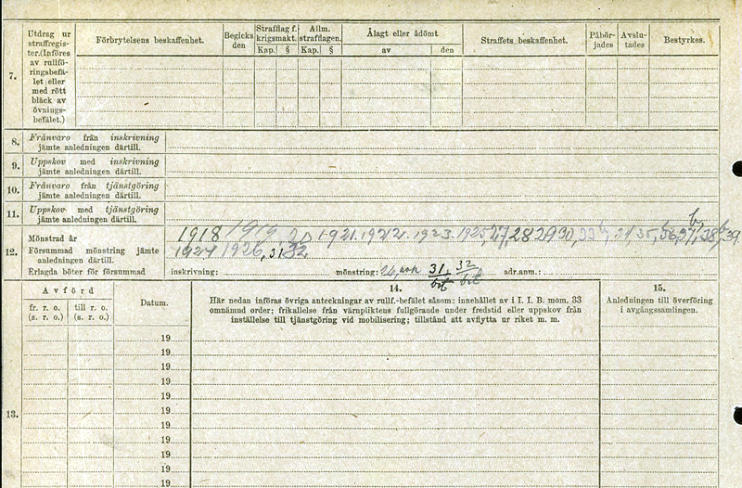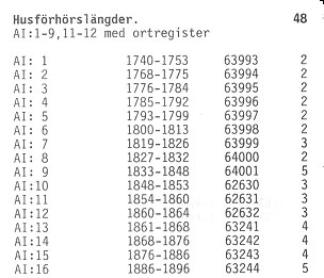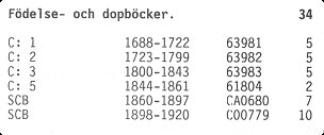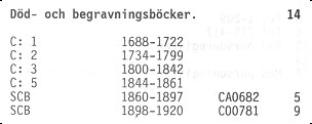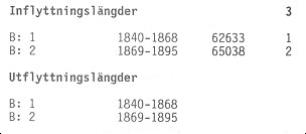

Copyright © Hans Högman 2017-04-23


Church Records
Sweden did not really have any equivalence to the
US birth, marriage or death certificates. Births,
marriages and deaths were instead kept in special
ledgers in each parish. So, what you want to look at
are these ledgers or church books / church records.
I guess you can get an excerpt of these records if
you ask the Archives but a better idea is to copy the
page with the actual entry in the church book, once
written by the parish minister.
•
Birth and baptising Records (Födelse- och
Dopboken)
•
Marriage Records (Vigselboken)
•
Death and burial Records (Dödsboken)
•
Moving Records (In- och Ut-flyttningslängder)
•
Household Examination Rolls or Clerical
Surveys Rolls (Husförhörslängder)
•
Confirmation Records (Konfirmationslängder)
•
Parish Record Extracts (uttdrag till Statistiska
Centralbyrån, SCB)
Death/Burials Records (Swedish:
Dödsboken, Döda/Begravna)
Record code: F.
Death records go as far back as the beginning of the
17th century. Like the other church records, the
death records were kept parish-by-parish and
ordered by year. For each death an entry was made
on that date in the parish where the burial took
place. The time period for the death records could
be as much as 50 years.
The first volume of death records within each parish
is called F:1, the second F:2 etc.
In some death records the deceased are listed by
burial date instead of death date. The burial was
normally held within a week from the death.
In the records you will find the name of the
deceased, death date, burial date, the age, place
of residence and cause of death. Stillborn
children were usually recorded.
Example of an extract from a death record:
Left-hand side:
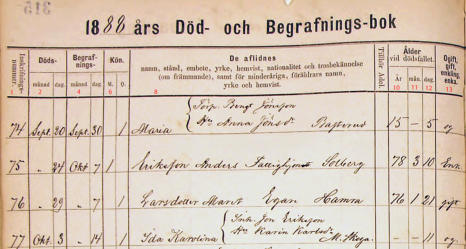
Genealogy in
Sweden
The above image is page 1 of a draft card
(värnpliktskort) for a draftee assigned to the infantry
(infanteriet) [Section 2 above].
The draftee’s name is Johan Anton Bergwall, born in
1894, and drafted in 1914 (section 1 above). His
enrollment number was 497 72/1914. He was drafted
at Piteå rullföringsområde (72) [draft board] which
belonged to Norrbottens inskrivningsområde
[Norrbotten enrollment area].
Section 5 above contains information regarding when
the draftee had served on duty; year (år), duty
(tjänstgöringens benämning) and number of days
(antal dagar).
He did his military service in the Norrbotten
Regiment (I19). In section 5 above there is a column
with the heading “Reg:t, station osv”. This column
contains information about the unit’s name. In this
case I19, which is the unit code for the Norrbotten
Regiment (Norrbottens regemente). This regiment
were garrisoned in Boden town, Norrbotten. "I" is short
for Infantry and I19 means the 19th infantry regiment.
More information about each unit’s code can be found
at: Unit codes (förbandsnummer).
Further, Bergwall served in the 3rd Company;
information that is found in the next column with the
heading "Komp., skv., batt. osv". Number “3” stands
for 3rd company.
Source; the above image can be found at: Norrbottens
inskrivningsområde (Io 19), Piteå rullföringsområde
(Ro 72) D4:3 (1914-1922) Bild 7770 (AID:
v806614a.b7770, NAD: SE/KrA/0473/B19002Ö).
Page 2:

Page 2 of the draft card is shown above.
Section 7 above contains information about possible
misconduct and punishment a draftee was charged
with while serving in the military. This draftee has no
notes in this section.
Section 12 has information about the draftee's service
periods.
Source: Norrbottens inskrivningsområde (Io 19), Piteå
rullföringsområde (Ro 72) (BD) D4:3 (1914-1922) bild
7780 (AID: v806614a.b7780, NAD:
SE/KrA/0473/B19002Ö).
Back to Military records list.
Where do I find the records?
Now days the Swedish church records, military records,
court records etc. are found online on the Internet
which makes it easy to do genealogy research.
There are three major online providers of these
records. They are:
•
SVAR
•
Arkiv Digital (AD)
•
Ancestry
You will need a subscription with one of the three
providers in order to browse the records.
All three providers have a complete set of church
records.
SVAR
SVAR is a division of the Swedish National Archive, is
the provider with most different types of records, in
other words most complete. SVAR has digitalized the
old black & white microfilm records which means the
records have a varying quality.
Arkiv Digital
Arkiv Digital has digitalized the original records with
modern technique and therefor have their records a
very high quality and they are in color. The AD image
database consists of about 210,000 historical books,
documents and records or 60 million digital color
images of Swedish church records, military records,
estate inventories, court records, tax/census records
and other historical records.
Ancestry
Ancestry, has like SVAR, digitalized the old black &
white microfilm records which means the records have
a varying quality.
See each provider's web site for detailed information
about the content of their respective image database!
The Church Record Codes
The following examples are from the parishes of Hög
and Hälsingtuna in Gävleborg Län (X).
The first column shows the record codes, the second
column the time period for each record.
Swedish Archives
•
The National Archives in Stockholm (Riksarkivet,
RA). http://www.riksarkivet.se/
Acts, documents and other sources are available
to the public unless otherwise stated in the Act of
Secrecy.
At the National Archives there is a printed guide
available to help you find the sources in the
Archive (Riksarkivets beståndsöversikt). Another
aid is NAD .
In Arninge, some kilometers north of Stockholm, is
the National Archive Reading Room for
genealogical research. The parochial records of
the whole of Sweden can be found there as
microfiche, from the 17th century unto the 1890s,
as well as records of immigrants and emigrants.
•
SVAR (Svensk Arkivinformation), a division of the
National Archive. https://sok.riksarkivet.se/svar-
digitala-forskarsalen
SVAR has online copies of most of the different
types of records that are kept in the National
Archive, the Regional archives and the War
archive.
•
The Regional Archives (Landsarkiven, LA)
http://www.riksarkivet.se/
•
The City Archives (Stadsarkiven, SA).
Stockholm City Archive:
http://stadsarkivet.stockholm.se/
•
The War Archives in Stockholm (Krigsarkivet)
http://riksarkivet.se/default.aspx?id=102108
•
The Royal Library in Stockholm (Kungliga
Biblioteket, KB) http://www.kb.se/
•
Military Museums: Army Museum (Stockholm),
Navy Museum (Karlskrona), Air Force Museum
(Linköping)
•
Swedish records online:
Arkiv Digital (AD), SVAR and Ancestry keep images
(digital photo copies) of various records online at
the Internet such as church records, military
records etc .
•
Demographic Database at Umeå University
(Demografiska databasen i Umeå)
The Demographic Data Base (DDB) is a national
research resource. Its principal responsibility is to
make historical records - 19th century parish
records and early statistical information - easily
available to researchers.
•
The House of Emigrants in Gothenburg. The
House of the Emigrants in Gothenburg is a
migration centre for research.
http://emigranternashus.se/
•
The Migration Center in Karlstad: Svenska
migrationscentret i Karlstad
•
The Swedish online Emigrant Database EmiWeb.
•
Swedish maps from The National Land Survey of
Sweden: http://www.lantmateriet.se/en/
•
The 1890 census online:
http://www.foark.umu.se/census/Index.htm
covers so far only the northern parts of Sweden
(English)
•
The Central Soldier Database - A soldier
database, free of charge to search for your
Swedish soldiers. Search page.
The Regional Archives
There are nine Regional Archives. Most records of
genealogical value are kept at the Regional Archives. All
archives are open to public. The Regional Archives:
http://www.riksarkivet.se/
•
The Regional Archive in Gothenburg
(Landsarkivet i Göteborg) covers the following
counties: Bohus län, Älvsborg län and Skaraborg
län.
•
The Regional Archive in Härnösand
(Landsarkivet i Härnösand) covers the following
counties: Gävleborg län, Västernorrland län,
Västerbotten län and Norrbotten län.
•
The Regional Archive in Lund (Landsarkivet i
Lund) covers the following counties: Malmöhus
län, Kristianstad län, Halland län and Blekinge län.
•
The Regional Archive in Uppsala (Landsarkivet i
Uppsala) covers the following counties: Uppsala
län, Örebro län, Västmanland län and Kopparberg
län.
•
The Regional Archive in Vadstena (Landsarkivet i
Vadstena) covers the following counties:
Östergötland län, Jönköping län and Kronoberg
län.
•
The Regional Archive in Visby (Landsarkivet i
Visby) covers the following county: Gotland län.
•
The Regional Archive in Östersund
(Landsarkivet i Östersund) covers the following
county: Jämtland län.
•
The Stockholm City Archive in Stockholm
(Stadsarkivet i Stockholm) covers the following
county: Stockholm län. The Stockholm City
Archive:http://stadsarkivet.stockholm.se/
•
The Värmland Archive in Karlstad
(Värmlandsarkiv i Karlstad) covers the following
county: Värmland län. The Värmland Archive:
http://www.regionvarmland.se/varmlandsarkiv/
Län = County.
Archives in the USA
•
FamilySearch, LDS
•
The Family History Library and the Family History
Centers, LDS
The Family History Library in Salt Lake City, Utah,
is the main repository of all the genealogical
information the Church of Jesus Christ of Latter-
day Saints (LDS) has collected. More than 3,400
branches of the main library, known as Family
History Centers, are located throughout the
world to help you search the records of your
ancestors. Use of the Family History Library and
Centers is free.
The Family History Library and Centers has
microfilmed Swedish church records up to 1920.
You can order the microfilm at a low cost. Contact
your closest Family History Center.
•
The Swanson Swedish Immigration Research
Center at Augustana Collage, IL.
The Research Center is a national archives and
research institute for the study of Swedish
immigration to North America. The Swanson
Swedish Immigration Research Center sells
microform copies of the records.
•
The Evangelical Lutheran Church in America
(Chicago, IL), ELCA, has microfilm of most Swedish
immigrant church records in the U.S. The
microfilm is available through Augustana Collage,
se above. http://www.elca.org/
•
Swegate, Sweden Genealogical Gate, a Gate to
Genealogical Research in Sweden
Other sources
The e-zine RÖTTER
The e-zine RÖTTER (Roots) is published by The
Federation of Swedish Genealogical Societies, a national
organization with over 38,000 members. RÖTTER is
both for beginners and more experienced researchers.
Most of the information is in Swedish, but many pages
also have English summaries. Roots:
http://www.genealogi.se/finding-your-swedish-roots
Rötter also has a Genealogy News Group called
Anbytarforum, where genealogists can meet and
discuss, ask questions etc. The discussions are both in
Swedish and English.
Anbytarforum: http://forum.genealogi.se/
To add or to answer a message go to the end of the
page, fill in your full name in the box marked:
Användarnamn, leave the box Lösenord blank and fill in
your e-mail address in the box: E-post. Then click on
the gray button "Förhandsgranska/Skicka meddelande"
(Pre view/send). After you have previewed it, click an
"Skicka meddelande" to Send or "Ångra" to Cancel.
At the top of the webpage you can set the language
to English “Choose language”.
When you add a query in a News Group, be specific,
add as much information you know about the person
you are looking for. It’s a waste of time to advertise “I'm
looking for more information about my great grandfather.
His name was Karl Andersson and came from Småland”.
To ask for information about a person with a common
name in a large area is like asking information on a
John Smith from Texas. It won't give you much.
Always give the name of the parish if you know it or at
least a name of a place together with the name of the
county or the province. And always give a time period
when your ancestor lived at that place. Add the date of
birth if you know it, information on wife, children, date
of emigration etc.
One of the major Swedish genealogy software is
DISGEN for Windows.
DISGEN: http://www.dis.se/
The parish
As mentioned several times on the page it’s important
to find the name of the parish where your ancestors
lived and the period of time were they lived there. This
is the key to the records.
However, what is a parish? The parish is a local
congregation that may have included many
neighboring villages in its boundaries.
In the records you will find the Swedish word socken
(short sn). In Swedish the modern word for parish is
församling (short fs).
In one sense socken means the same thing as a church
parish, a congregation. But socken was also the area
for local government ruled by the Sockenstämma (the
council of the socken), i.e. the wordly socken.
A socken had a church and the boundaries of the
church parish and the socken was the same.
In the 1860s the municipalities (kommun) replaced the
worldly socken.
See Swedish parishes. At this site you will find all the
Swedish parishes, arranged by municipality. Use your
browser’s search function to check if the name of a
place you have is the parish name (församling) or not.
At the above mentioned link you ill also find the
Swedish municipalities. See also Subdivisions of
Sweden into regions, provinces and counties.
The Conception of Socken
Swedish Land Reforms
Seeking information about
Swedish ancestors by their last
name
See Seeking information about Swedish ancestors by
their last name
Literature
•
Cradled in Sweden by Carl-Erik Johansson, Logan
Utah, 1995.
•
Swedish Passenger arrivals in the United States
1820–1850, by Nils William Olsson och Erik Wikén,
1995.
•
24 Famous Swedish Americans and their Ancestors,
1996.
•
Släktforska! Steg för steg (Guide book to Swedish
Genealogy) by Per Clemensson and Kjell
Andersson, Stockholm 1997, 5th edition.
•
Emigrantforska! Steg för steg (Guide book to
Swedish emigrant research) by Per Clemensson,
1996.
•
Hembygdsforska! Steg för steg (Guide book to Local
History Research in Sweden) by Per Clemensson
and Kjell Andersson, Stockholm 1990.
•
Statistiskt sammandrag av det svenska
indelningsverket (Statistical Digest of the Swedish
Allotment System) by Claes Grill.
Genealogy Links
•
Genealogy Links (opens in a new window)
Registers on CD/DVD-ROM
•
Svenska ortnamn, Names of places in Sweden
(400.000 places listed)
•
NAD (The National Archive Database on CD). Lists
the sources that can be found in the Swedish
archives (by the National Archive)
•
Emigranten, two CDs with a database covering
Swedish emigrants.
•
Centrala Soldatregistret, Military records
covering (at this point - Aug 2017) about 507,000
soldiers within the Allotment System 1682 - 1901
(Indelningsverket).
•
Sveriges befolkning 1880, The Swedish 1880
census on a CD/DVD. It contains all persons who
were registered in a Swedish parish on December
31, 1880 - almost 4.6 milion records.
•
Sveriges befolkning 1890, The Swedish 1890
census on a CD/DVD. It contains information
about the 4.8 million persons living in Sweden at
the turn of 1890/1891.
•
Sveriges befolkning 1900, The Swedish 1900
census on a CD/DVD. It contains all persons who
were registered in Sweden in the end of 1900, 5.2
million people.
•
Sveriges befolkning 1910, The Swedish 1910
census on a CD/DVD.
•
Swedish Death Index 1901 - 2013. This is the fifth
edition of the Swedish death index. This edition
has been updated with information about 2.5
million deceased during the period 1901-1946,
which means that 70% of the dead for that period
are added since last edition. From 1947 and
forward are all deceased included, where the
period 2007-2009 is completed with 272 000 since
last version. The DVD-rom contains 7 880 000
deceased in all.
•
Sveriges befolkning 1970, The Swedish
population 1970. It contains information about the
8.0 million persons living in Sweden in 1970.
•
Sveriges befolkning 1980, The Swedish
population 1980. It contains information about the
8.3 million persons living in Sweden in 1980.
•
Sveriges befolkning 1990, The Swedish
population 1990. It contains information about the
8.6 million persons living in Sweden in 1990.
•
Söder i våra hjärtan (Söderskivan) - Södermalm
in our hearts. Södermalm is a district (and an
island) just south of the Stockholm city center and
this CD covers the population living here in 1900.
•
Klaraskivan - The Klara CD. Klara is a parish in
central Stockholm and this CD covers the
population living here 1878-1926.
•
Gamla stan under 750 år - The Stockholm Old
Town during 750 years. This CD and DVD informs
you about the history of the Stockholm Old Town
and about the persons living here between 1878
and 1926.
•
Sjöfolk - Sailors in the merchant navy. A CD with
all the sailors registered at 10 of Sweden's
mercantile marine offices, about 700.000 entries.
Top of page
Above is an extract from a death record: Ekshärad (S)
F:5 (1870-1894) image 163 / page 317 (AID:
v6433.b163.s317, NAD: SE/VA/13100). Left-hand
page.
This record covers year 1888 for Ekshärad parish,
Värmland (S). AID is the image ID used by Arkiv Digital.
The above image shows four entries in the Ekshärad
death book for 1888.
The first entry (74) is for a 15-year old girl Maria. She
died on September 20, 1888. Since she was young also
her parent's names are listed; tenant farmer Bengt
Jönsson and his wife Anna Jönsdotter in Basterud,
Ekshärad parish. The burial took place on September
30.
The second entry (75) is for pauper (fattighjon)
Anders Eriksson, Solberg, Ekshärad parish. He died 78
years old on September 24, 1888. He was then a
widower. The burial took place on October 7.
The third entry (76) is for Marit Larsdotter, Hamra,
Ekshärad parish. She died 76 years old on September
29, 1888. She was married. The burial took place on
October 7.
The fourth entry (77) is for barley 11-days old Ida
Karolina. She was a daughter to Jon Eriksson and Karin
Karlsdotter, M. Skoga, Ekshärad parish. Ida died on
October 3, 1888. The burial took place on October 14.
Explanations:
•
1st column: entry number in the death book for
1888.
•
2nd and 3rd columns: Date of death. Månad
(month), Dag (day).
•
4th and 5th columns: Date of burial. Månad
(month), Dag (day).
•
6th and 7th columns: Gender; M = male, Q. =
female
•
8th column: Name of the deceased, occupation,
place of residence
•
9th column: Member of the nobility (Tillhör adel)
•
10th, 11th and 12th columns: Age of the
deceased; År (years), Mån. (months), dag. (days)
•
13th column: marital status; og. = ogift
(unmarried), gift (married), enk. (änka or änkling)
widow or widower
Right-hand side:
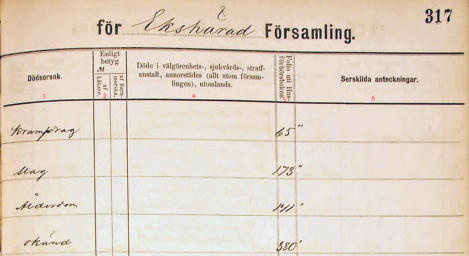
Above is an extract from a death record: Ekshärad (S)
F:5 (1870-1894) image 163 / page 317 (AID:
v6433.b163.s317, NAD: SE/VA/13100). Right-hand
page.
The above image shows the right-hand side of the
page shown further above.
The first column above lists "cause of death"
(dödsorsak). Kramp = cramp/spasm/convulsion, Slag =
stroke, Ålderdom = old age (infirmity), Okänd =
unknown. For further information, see Names of
Diseases
Explanations:
•
1th column: Cause of death
•
2nd and 3rd columns: certificates: By doctor (af
läkare), by midwife (af barnmorska)
•
4th column: Notations about social care, medical
care, penal institutions etc.
•
5th column: Page in the parish book
•
6th column: Remarks
Back to Church records list.
Moving Records (Swe: In- och
Utflyttningslängder)
Record code: B.
The Household Examination Rolls normally have a
notation about a person's moving in or out of a parish.
The rolls also have notes of moving between
addresses within the parish.
There are also special records, In- och
Utflyttningslängder (Moving-In / Moving-Out records),
which lists people moving to and from a parish. These
records have not always been preserved. You are most
likely to find moving records for the 19th century.
Inflyttning = moving-in and utflyttning moving-out.
They are kept chronologically, giving the person's
name, occupation and marital status. The records
show which parish a person moved from or was
moving to. A person moving out from a parish had to
obtain a moving certificate (flyttningattest) from the
parish minister. This certificate had to be presented to
the parish minister of the new parish.
The first volume of moving records within each parish
is called B:1, the second B:2 etc.
Back to Church records list.
Example of extracts from the moving records:
Moving-out record (Utflyttningsbok):
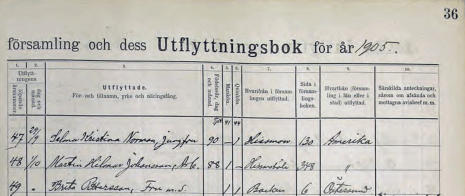
Above is an extract from a moving-out record: Rödön (Z)
B:4 (1902-1915) image 240 / page 36 (AID:
v115161.b240.s36, NAD: SE/ÖLA/11090).
The above moving-out extract covers year 1905 for
Rödön parish Jämtland (Z). AID is the image ID used by
Arkiv Digital.
The first entry (47) is for Selma Kristina Norman,
Hismon, Rödön parish. She emigrated from Sweden to
"Amerika" (America) on September 29 [29/9], 1905.
Her occupation was maid (jungfru). She is listed on
page 130 in the Rödön parish book (församlingsbok).
Selma Kristina was born 1890 which means she was
only 15 years old when she left Sweden.
The second entry (48) is for Martin Hilmar Johansson,
Hismoböle, Rödön parish. He emigrated from Sweden
to "Amerika" (America) on October 1 (1/10) 1905. His
occupation was laborer (Arb.). He is listed on page 348
in the Rödön parish book (församlingsbok).
The third entry (49) is for Brita Pettersson, Backen,
Rödön parish. She moved to the city of Östersund,
Jämtland (Z) on October 1 (1/10) 1905. She is listed on
page 6 in the Rödön parish book (församlingsbok).
Explanations:
•
1st column: entry number in the moving-out
record for 1905, Rödön parish.
•
2nd column: Date of moving out, Day (dag) and
Month (månad).
•
3rd column: Name and occupation of the people
moving out, "Utflyttade".
•
4th column: Date of birth (födelsedag).
•
5th column: Gender, males (mankön).
•
6th column: Gender, females (qvinkön).
•
7th column: Place of recidence in the current
parish.
•
8th column: Page in the parish book in the
current parish.
•
9th column: Place (parish, city, country) of the
new place of recidence (whereto).
•
10th column: Remarks
Moving-in record (Inflyttningsbok):
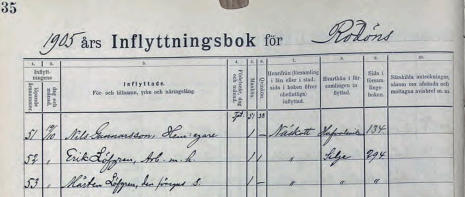
Above is an extract from a moving-in record: Rödön (Z)
B:4 (1902-1915) image 240 / page 36 (AID:
v115161.b240.s36, NAD: SE/ÖLA/11090).
The above moving-in extract covers year 1905 for
Rödön parish Jämtland (Z). AID is the image ID used by
Arkiv Digital.
The first entry (51) is for Nils Gunnarsson. He moved-
in to Rödön parish on October 19, 1905, from Näskott
parish, Jämtland. He is listed as "Hem:egare" which is
Hemmansägare" and means freeholder or farmer in
English. Nils is listed on page 134 in the Rödön parish
book (församlingsbok).
The second entry (52) is for Erik Löfgren. He moved-in
to Rödön parish on October 19, 1905, from Näskott
parish, Jämtland. His occupation was laborer (Arb.). He
is listed on page 294 in the Rödön parish book
(församlingsbok).
The third entry (53) is for Mårten Löfgren. He moved-
in to Rödön parish on October 19, 1905, from Näskott
parish, Jämtland. He is listed on page 294 in the Rödön
parish book (församlingsbok). After his name is a note
"den föreg. s." or "den föregåendes son" or in English
"the former's son". So, Mårten was a son of Erik
Löfgren.
Explanations:
•
1st column: entry number in the moving-in
record for 1905, Rödön parish.
•
2nd column: Date of moving in, Day (dag) and
Month (månad).
•
3rd column: Name and occupation of the people
moving in, "Inflyttade".
•
4th column: Date of birth (födelsedag).
•
5th column: Gender, males (mankön).
•
6th column: Gender, females (qvinkön).
•
7th column: Name of the former parish (from
where).
•
8th column: Place of residence in the current
parish.
•
9th column: Page in the parish book in the
current parish.
•
10th column: Remarks
Summary Church Records

The X's marks the Records where you will find the
information in. The (X) marks the Records where you
might find the information in.
Statistiska Centralbyrån, SCB)
The Church Records from 1860 and onward were
extracted annually and sent off to Statistiska
Centralbyrån, SCB (Statistics Sweden) in Stockholm. In
1992 they were forwarded to Riksarkivet (The National
Archive).
These records contain extracts of the birth, marriage
and death records of all parishes in Sweden. They are
cataloged by year and county.
These extracts are easy to use as they are
standardized for the whole nation. Web address: SCB
Back to Church records list.
Contents of the Military Records
There is much information to be found in the military
rolls if your ancestor has been a soldier or an officer.
General Muster Rolls (Swe:
Generalmönsterrullor, GMR)
A general muster (GM) was held at each regiment
every 3rd year (later every 5th year). The general
muster rolls (GMR) were kept at every regiment and
since a new general muster roll was set up at each
general muster you must know the time frame when
your soldier served in the regiment.
A general muster was an inspection of the regiment,
where its strength in numbers, equipment, etc. was
noted. The GMRs were kept between 1685 and 1885.
The GMRs were kept regiment-by-regiment and within
each general muster roll the soldiers were listed
company-by-company. So you need to know the
regiments name but it is a good thing if you also know
the company of your soldier.
Example of an extracts from a general muster roll:
General Muster Roll (Left-hand side):
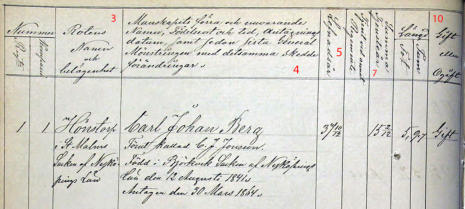
Above is an extract from a General muster roll:
Generalmönsterrullor - Södermanlands regemente (D)
169 (1879-1883) image 890 (AID: v372963a.b890, NAD:
SE/KrA/0023). Left-hand side.
The above extract shows a GMR for the Södermanland
Regiment (infantry). The general muster was held on
June 18, 1879. AID is the image ID used by Arkiv
Digital.
The image is an extract of the soldiers of the Life
Company and in this case soldier number 1, Carl Johan
Berg. Berg served in the Life Company.
Berg's soldier number was No 1, both within the
regiment as well as within the company since the Life
Company was the 1st Company. The name of the
"rote" was Hönstorp, which was located in St. Malm
parish, Södermanland (D). Södermanland Län was
formerly called Nyköping Län.
The text in the third column reads: Carl Johan berg,
formerly known as C. J. Jonsson, born on August 12,
1841, in Björkvik parish, Nyköping Län (county). Berg
was enrolled on March 30, 1864.
Berg was his soldier name, while Jonsson was his
patronymic.
The 5th column (age) shows that berg was 37 years
and 10 months old at the time of the muster and the
7th column shows that he then had 15 years and 2
months of service time. Berg's height was 5' 9". His
marital status was "gift" (married).
Explanations:
•
1st column: Soldier numbers; Soldier number
within the regiment, normally 1 - 1,200.
•
2nd column: Soldier numbers; Soldier number
within the company, normally 1 - 150.
•
3rd column: Name and location of the "rote".
•
4th column: Name of the soldier
•
5th column: Age of the soldier at the time of the
muster.
•
6th column: Number of years served in another
regiment
•
7th column: Number of service years at the time
of the muster
•
8th and 9th columns: Height of the soldier
(Längd); foot and inches (fot and tum).
•
10th column: marital status (Gift eller ogift). Gift =
Married, Ogift = unmarried.
General Muster Roll (Right-hand side):
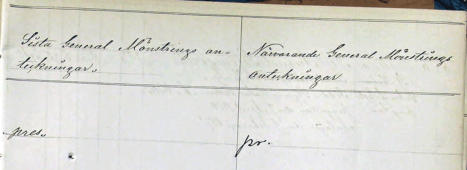
Above is an extract from a General muster roll:
Generalmönsterrullor - Södermanlands regemente (D)
169 (1879-1883) image 890 (AID: v372963a.b890, NAD:
SE/KrA/0023). Right-hand side.
The above extract shows a GMR for the Södermanland
Regiment (infantry) in 1879.
Berg was present at the previous general muster as
well as at the current general muster (pres. / pr.).
Explanations:
•
1st column: Notations transferred from the
previous general muster roll.
•
2nd column: Notations made at the current
general muster.
Typical notations in those two columns:
•
Pres/Präs, Pr., Presens or Praesens: Soldier
personally present at the muster.
•
Abs. or Absens: Soldier absent at the muster.
•
Appr. or Approbera: approved as a soldier at the
muster.
•
Avsked/afsked: The soldier was discharged.
•
Sjuk: The soldier was absent at the GM due to
sickness/injury.
Back to Military records list.
Draft Cards (Swe: stamkort/värnpliktskort)
Conscription:
In 1812 Sweden introduced a military conscript
system called Beväringen. Every male between the
age of 21 to 25 was required to serve in the military as
a conscript (draftee). Beväringen was a complement
and reinforcement to the regular professional army.
The conscription service was universal which meant
that all able-bodied men fit for military service had to
undergo a minimum military training in the armed
forces. Hiring of substitutes was allowed until 1862,
i.e. to pay someone to do the service in his place.
The enrollment numbers (inskrivningsnummer) were
introduced in 1885 and were a three-part conscript
identification number.
In 1901 both the standing allotted army and the
Beväringen was abandoned and instead Sweden
established an army and navy entirely based on a
Universal conscription System called Allmän
Värnplikt (Universal Conscription). This new conscript
system was to fully replace the old standing Army and
Navy with a military force fully based on conscription.
In a way Beväringen was a forerunner to the Universal
Conscription System.
Draft cards:
The general muster rolls were kept until the 1880's.
They were then replaced by the "stamrullor" and
"stamkort" (draft cards).
The American draft card is just a registration card
while Swedish cards serve a dual purpose in that they
also contain service data the American doesn't have.
Example of a Draft Card (Värnpliktskort /
Stamkort):
Page 1:
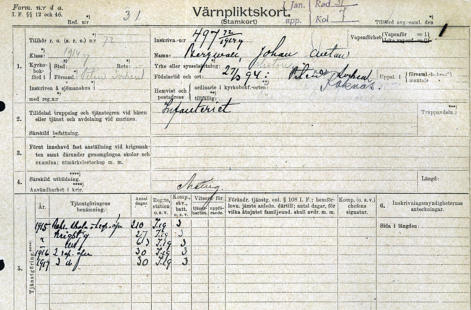
Household Examination Rolls (AI)
Record codes for Hög parish (X).
Birth and Baptising Records (C)
Record codes for Hälsingtuna parish (X).

Banns and Marriage Records
Record codes for Hälsingtuna parish (X).
Death and Burial Records
Record codes for Hälsingtuna parish (X).
Extracts of the church records began in 1860. The
extracts were sent to the Statistiska Centalbyrån,
SCB (Statistics Sweden).



Moving records (B)
Record codes for the Hög parish (X).
Confirmation Records (DI)
Record codes for Hälsingtuna parish (X).


General Muster Roll for the Södermanland Regiment
(D).
This image shows musters the regiment held in
the17th and 18th century.







